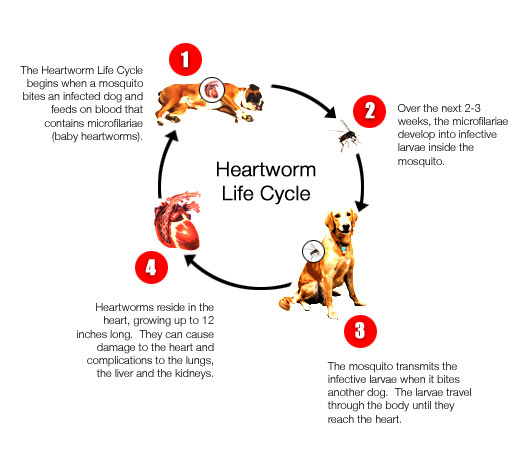Understanding Heartworm Infection

Do you know that
heartworms, also known as Dirofilaria immitis, can spread from one dog to another?
Well... Actually, heartworms do not get transmitted directly from one dog to another. This means that heartworm disease is not contagious. It is transmitted by a mosquito. When a mosquito bites a heartworm-infected dog, it feeds on blood that contains
microfilariae (microscopic, immature offsprings of heartworms) and it becomes a carrier of the infection.
It takes 10 to 14 days for the microfilariae to develop into infective larvae inside the mosquito. After that, when the infected mosquito bites another dog, these infective larvae are transmitted through the bite wound and cause an infection.
Once in the dog's body, the infective larvae will travel throughout the body until they reach the heart, where they will reside and mature into adults. It takes approximately a little over 6 months for the infective larvae to become adult worms. Some adults can grow as much as 14 inches long. It is also at this stage when they start to produce microfilariae, which will circulate in the bloodstream. When an uninfected mosquito bites this dog, it picks up the microfilariae and the cycle of infection starts again.
Heartworms can live in a dog for 5 to 7 years and aside from causing damage to the heart, they also cause dysfunction and complications to the lungs, the liver, and the kidneys.
In canine heartworm infection, it is important to note that the development of adult heartworms takes 6 to 7 months (184 to 210 days). Also, its only natural agent for transmission is the mosquito, so it is only logical that heartworm infection is more prevalent in areas where mosquitoes abound.
Now that you know how heartworm disease is transmitted, you can help protect your dog by getting rid of those pesky mosquitoes that carry the infection. Why don't you start by cleaning your homes to keep mosquitoes away?

